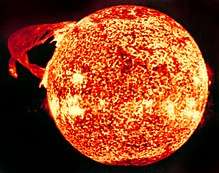Polarimeter to Unify the Corona and Heliosphere
Polarimeter to Unify the Corona and Heliosphere (PUNCH) is a future mission by NASA to study the unexplored region from the middle of the solar corona out to 1 AU from the Sun. PUNCH will consist of a constellation of four microsatellites that through continuous 3D deep-field imaging, will observe the corona and heliosphere as elements of a single, connected system. The four microsatellites are planned to be launched in February 2023, along with a pair of secondary satellites named Tandem Reconnection and Cusp Electrodynamics Reconnaissance Satellites (TRACERS).[4]·[3]·[2]
| Mission type | Heliophysics |
|---|---|
| Operator | NASA |
| Website | punch |
| Spacecraft properties | |
| Spacecraft | PUNCH |
| Spacecraft type | Orbiters (4) |
| Bus | CYGNSS |
| Manufacturer | Southwest Research Institute (SwRI), San Antonio, Texas |
| Dry mass | 40 kg (each) |
| Start of mission | |
| Launch date | February 2023 [1][2] |
| Rocket | TBD |
| Orbital parameters | |
| Reference system | Geocentric |
| Regime | Low Earth, Polar sun-synchronous |
| Altitude | 570 km [3] |
| Instruments | |
| Narrow Field Imager (NFI) - 1 satellite Wide Field Imagers (WFIs) - 3 satellites | |
Small Explorer program (SMEX) | |
On 20 June 2019, NASA announced that PUNCH and TRACERS were the winning candidates to become the next missions in the agency's Small Explorer program (SMEX).[2]
PUNCH is led by Craig DeForest at the Southwest Research Institute (SwRI) in Boulder, Colorado. Including launch costs, PUNCH is being funded for no more than US$165 million.[2]
Objective
The stated primary objective by PUNCH's mission is "to fully discern the cross-scale physical processes, from microscale turbulence to the evolution of global-scale structures, that unify the solar corona and heliosphere".[5] In other words, the mission aims to understand how the solar corona becomes the solar wind.[6]
The two specific goals are to understand how coronal structures become the ambient solar wind, and to understand the dynamic evolution of transient structures in the young solar wind.[5] The Principal Investigator, Craig Edward DeForest from Southwest Research Institute (SwRI), thinks that such closer study will also lead to a better understanding of the causes of solar weather events like coronal mass ejections (CMEs), which can damage satellites and disrupt electrical grids and power systems on Earth.[3]·[2]
The more we understand what drives space weather and its interaction with the Earth and lunar systems, the more we can mitigate its effects – including safeguarding astronauts and technology crucial to NASA's Artemis program to the Moon.[7]
Instruments
The mission configuration consists of a constellation of four observatories, each carrying one instrument.[8]
- The Narrow Field Imager (NFI) sits on only one spacecraft, and is an externally occulted visible-light coronagraph.
- The Wide Field Imagers (WFIs) are side-looking heliospheric imagers with planar-corral baffles that sit on the remaining 3 spacecraft.
The fields of view of the 3 WFIs overlap slightly with each other and with the NFI, and the instruments' operation is synchronized. The instruments operate through polarized Thomson-scatter imaging of the transition from corona to heliosphere.[9] PUNCH integrates images from its constellation of small satellites into a global composite after each orbit, covering ~6 orders of magnitude dynamic range. Through a stream of these images, PUNCH achieves 3D feature localization and accurate deep field imaging.[10] The mission builds on CYGNSS experience with smallsat constellations.[11]
Collaborations
Phase B will last nearly a full year. Throughout the process, SwRI will collaborate with the U.S. Naval Research Laboratory (NRL) and the Rutherford Appleton Laboratory in Oxfordshire, England.
PUNCH, which will operate in low Earth orbit, will work in synergy with NASA's Parker Solar Probe and the ESA's Solar Orbiter.[3]·[9]
References
- "SwRI-led PUNCH mission to image Sun's outer corona enters Phase B". Southwest Research Institute (Press release). 26 September 2019.
- NASA Selects Missions to Study Our Sun, Its Effects on Space Weather. NASA Press Release. 20 June 2019.
- NASA selects PUNCH, a new mission to study the Sun. Korey Haynes, Astronomy Now. 21 June 2019.
- Press Release from: Southwest Research Institute (SwRI). 20 June 2019.
- PUNCH: Objectives. Southwest Research Institute (SwRI). Accessed on 20 June 2019.
- PUNCH: Motivation. Southwest Research Institute (SwRI). Accessed on 20 June 2019.
- https://www.nasa.gov/press-release/nasa-selects-missions-to-study-our-sun-its-effects-on-space-weather - 20 Juin 2019
- PUNCH Mission Instruments. Southwest Research Institute (SwRI). Accessed on 20 June 2019.
- "The PUNCH Mission" (PowerPoint) Jackie Davies (UK Science Lead). 2018 Solar Missions Forum.
- PUNCH: Science. PUNCH Home site. Southwest Research Institute (SwRI)]. Accessed on 21 June 2019.
- PUNCH: Heritage. PUNCH Home site. Southwest Research Institute (SwRI)]. Accessed on 21 June 2019.


.png)